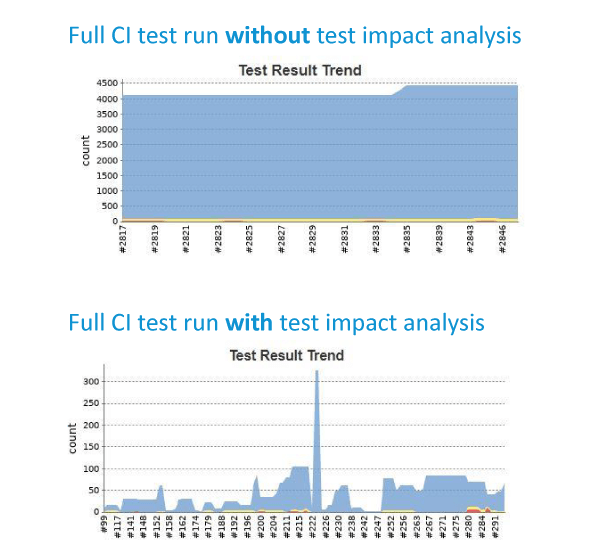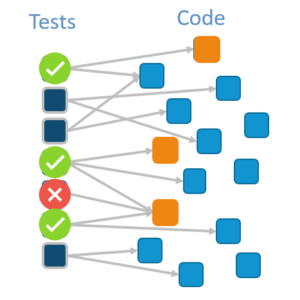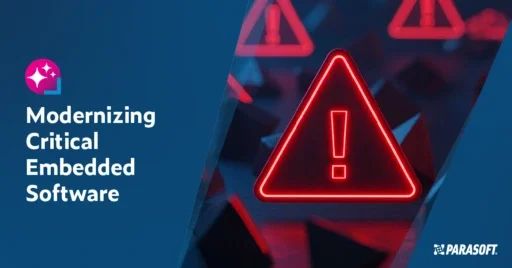Use Agentic AI to generate smarter API tests. In minutes. Learn how >>
Jump to Section
Improving Test Execution Efficiency With Test Impact Analysis
Every code change carries risk, but what if developers could get rapid feedback to know whether their changes are safe? Discover how test impact analysis increases test execution efficiency.
Jump to Section
Jump to Section
In software development, change is inevitable. More than that, it keeps software systems relevant, efficient, and resilient. As technology advances at a relentless pace and user demands grow increasingly complex, the ability to adapt and evolve software is paramount.
Test impact analysis (TIA) increases test execution efficiency while ensuring code modifications don’t introduce unintended defects. TIA pinpoints the tests that need to be run and validates code changes quickly. As a result, teams can confidently make swift changes.
Test impact analysis isn’t a novel concept. However, its prominence has grown substantially in recent years. In the past, software testing primarily focused on static, pre-release assessments aimed at finding and addressing defects. This approach often falls short when dealing with the dynamic nature of modern software, where change is constant.
In other words, the rise of Agile and DevOps methodologies, rapid development cycles, and continuous integration practices have all reinforced the need for a more adaptable, proactive, and on-the-go testing strategy.
With test impact analysis, there’s a fundamental shift in how we validate software, especially for large and complex systems. Instead of waiting for long test runs to complete and possibly delaying the work, this approach assesses the impact of changes on existing code, ensuring that each modification is rigorously tested to maintain overall system stability.

Understanding Test Impact Analysis
Test impact analysis is a software testing methodology that revolves around assessing and verifying the impact of specific changes made to a software application during its development or maintenance. Instead of running the entire test suite with every commit, TIA automatically and intelligently selects only the subset of test cases that correlate to those recent changes, optimizing build times and reducing resource consumption.
In a continuous integration (CI) pipeline, TIA typically works as follows:
- Code coverage analysis. Code coverage is captured and analyzed from baseline unit, functional, and UI test executions, mapping lines of code to the corresponding test cases that validate them.
- Detects code changes. A code diff is performed from a baseline build where you last ran your full regression test suite to identify what has changed.
- Maps changes to tests. Code changes are mapped to the individual unit, integration, or regression tests that cover the modified code.
- Executes only necessary tests. TIA automatically executes via a command-line interface (CLI) the subset of test cases that correlate to the code changes instead of the full suite, accelerating validation without sacrificing coverage.
- Provides rapid feedback. Developers receive immediate test results, allowing them to address failures before merging the code.
By integrating TIA into CI workflows, teams minimize unnecessary test execution, optimize infrastructure costs, and accelerate development cycles while ensuring that every code change is properly validated.

Live Unit Testing: TIA in the IDE
While test impact analysis in CI/CD ensures confidence in continuous builds, live unit testing applies the same concepts within the IDE, building developer confidence earlier by providing rapid feedback as code is modified.
As developers make changes to existing code and save their work within the IDE, live unit testing automatically runs in the background. It identifies the subset of unit tests relevant to the recent changes and executes them in real time.
Developers can see test results as they code, catching potential failures immediately. They can refine their changes before pushing new code to a shared branch. This automated workflow has its benefits:
- Improves productivity.
- Reinforces test-driven development practices
- Minimizes the chance of defects reaching later stages of the SDLC.
By integrating live unit testing into the development workflow and complementing it with TIA, teams create a seamless quality assurance strategy that efficiently validates changes locally as code is being modified in CI/CD pipelines.
Benefits of Implementing Test Impact Analysis and Live Unit Testing
Implementing test impact analysis and live unit testing offers numerous benefits for software development and quality assurance processes.
- Increased efficiency. Test impact analysis and live unit testing enhance testing efficiency as they target test executions on only the specific areas affected by code changes. This means that instead of retesting the entire application, which can be time-consuming and resource-intensive, only a subset of test cases related to the changes needs to be executed. This approach reduces redundancy, accelerates testing cycles, and enables faster development iterations.
- Faster feedback. With TIA and live unit testing, developers can quickly ascertain whether they have introduced new defects and whether their modifications have been successfully integrated. With this rapid feedback loop, developers can have greater confidence when they make code changes, address issues promptly, while preventing the propagation of errors and reducing development cycle times.
- Reduced resource usage. TIA helps reduce CI/CD pipeline resource consumption by executing only the test cases relevant to recent code changes. By minimizing unnecessary test execution, TIA frees up pipeline capacity, allowing teams to support more projects, accelerate delivery cycles, and allocate testing resources more effectively.
- Reduced context switching. When defects are found in the later stages of development, the developer’s ability to focus on writing new code is often disrupted for defect analysis and remediation. Live unit testing enables developers to work more efficiently and confidently, knowing their changes have been thoroughly tested before integration. Minimizing disruptions boosts developer productivity and morale.
- Enhanced software quality. TIA and live unit testing empower developers and testers to validate code changes within the sprint, reducing the workload after full regression runs. Without these capabilities, teams often wait for complete regression cycles to verify changes, as manually identifying relevant tests is time-consuming and prone to errors. By enabling targeted test execution and early issue detection, TIA and live unit testing free up time for teams to create new test cases that address coverage gaps—ultimately improving software quality.
- Facilitates Agile workflows. Test impact analysis and live unit testing are well-suited for Agile development methodologies and continuous integration/continuous delivery (CI/CD) pipelines. In Agile environments, where rapid and frequent code changes are the norm, they help ensure that software updates can be released without delays.
- Cost savings. Implementing TIA can lead to cost savings in multiple ways. It reduces the time and resources required for testing, minimizing expenses associated with extensive test suites and regression testing. Early defect detection and quicker issue resolution also save costs by preventing defects from reaching later stages of development or production, where they can be more expensive to fix.
Embracing Test Impact Analysis and Live Unit Testing for Better Software Development
Implementing test impact analysis and live unit testing is a fundamental step toward achieving better software development. The continuous evolution crisscrossing the software industry demands more efficient and adaptable testing methodologies. These testing techniques provide a fresh perspective by emphasizing adaptability. The shift from rigid, static testing plans to a dynamic, more responsive approach enables teams to keep pace with the ever-changing software landscape and address emerging challenges proactively.
Test impact analysis and live unit testing eliminate the uncertainty of software changes. Developers no longer have to suffer through long wait times to find out whether their modifications will break something. Instead, get rapid, targeted feedback.
By integrating these techniques into development workflows, teams can move faster, innovate freely, and make every code change with confidence. From a user perspective, TIA also helps deliver software solutions that are responsive to meeting their evolving needs.
To succeed in implementing test impact analysis and live unit testing, organizations should invest in the right tools and foster a culture of continuous learning. By doing so, they can create a development and testing environment that thrives on change.
See how your teams can get faster feedback on application changes using Parasoft’s Test Impact Analysis.




